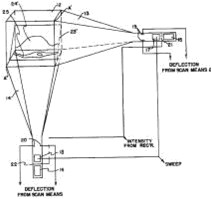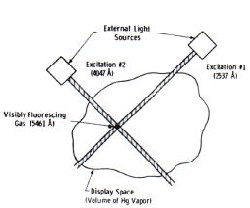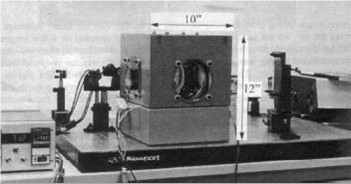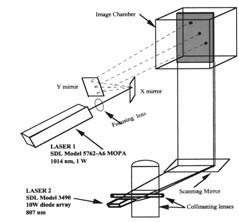
|


|

|
Either scroll down to view the complete Hall of Fame or choose the type:
The Felix3D Team has spent a lot of time researching the history of volumetric imaging. Nevertheless we ask you to help us by completing this Hall of Fame, so please send us descriptions and pictures of yet unknown (or here only preliminary stated) experimental setups or prototypes. We would be glad for any new descriptions and if possible one photo of the display and one of the researching team.
swept volume techniques
a) flat surface display
b) curved surface display
c) oscillating screen display
static volume techniques
d) solid state display
e) gaseous state display
other techniques
f) miscellaneous display type
Gaseous static volume displays

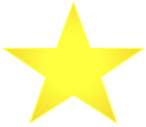
|
 Electron beams intersecting in nitrogen gas filled image space
Electron beams intersecting in nitrogen gas filled image space
F. S. Howell
1945
|
Electron beams intersecting in nitrogen gas filled image space.
|
|
|
|


|
 Multiple-step excitation in mercury vapor
Multiple-step excitation in mercury vapor
R. Zito, Jr.
1962
|
Multiple-step excitation in mercury vapor
|
|
|
|


|
 Two-step excitation of fluorescence in iodine monochloride vapor
Two-step excitation of fluorescence in iodine monochloride vapor
R. H. Barnes, C. E. Moeller, J. F. Kircher, C. M. Verber
1974
|
Two-step excitation of fluorescence in iodine monochloride vapor
|
|
|
|


|
 ThreeDimensional display devices
ThreeDimensional display devices
Rowe, William Guy
1977
|
Three-dimensional images are produced within a transparent cathode-ray tube by directing a plurality of electron beams into a cloud of phosphorescent particles and causing the beams to intersect at a point within the cloud. Each individual beam's current is maintained at less than the threshold of luminescence of the particles but the combined currents may be caused to exceed that threshold by a controlled amount thereby producing light spots of variable brightness at the beam intersection point, which point may be directed into any part of the volume of the cloud. The particle cloud is produced by a high-gradient electric field pump. Use of the pump for particle cloud production in such applications as beam testing is also described.
|
|
|
|


|
 Intersecting laser beams in rubidium vapor
Intersecting laser beams in rubidium vapor
I. I. Kim, E. Korevaar, and H. Hakakha
1989
|
Intersecting laser beams in rubidium vapor
|
|
|
|


|
 Three-color, solid-state, three-dimensional display
Three-color, solid-state, three-dimensional display
E. Downing, L. Hesselink, J. Ralston, R. Macfarlane
1994
|
In 1994 a group around Elizabeth Downing improved this type of 3D display (Figures 9, 10). In this sense the display volume consists of rare earth doped heavy metal fluoride glass; the excitation source are three pairs of commercially available infrared lasers. In order to achieve a three color display, Downing used three different dopants, Praseodymium for red, Thulium for blue and Erbium for green. As the mixing of the three rare earth elements causes many problems with their energy levels, thin layers of 100 to 500 Ám each single doped were laminated together with index-matching optical adhesive. The concentration of the dopants is around 0.5 mol%, which maximizes voxel brightness. Higher concentrations lead to increased single frequency upconversion which draws unwanted visible lines into the display volume. Each dopant is activated by a suitable wavelength combination of intersecting lasers. By using computer controlled scanners and mirrors, voxels can be ?turned on? everywhere inside the display volume and thus form complex structures. As voxels disappear shortly after removing the excitation source, whole pictures have to be refreshed regularly. A rate of 30 to 100 Hz avoids flickers.
|
|
|
|


|
 Three dimensional volumetric display
Three dimensional volumetric display
Whitesell, Eric James; Scheps, Richard
2002
|
A three dimensional display provides a true 3-D display of an image defined by luminous voxels within a virtually transparent volume. The voxels may be generated by illuminating a virtually transparent fluorescent gas or dye with beams of excitation energy that cause the gas or dye to emit light at voxels where the energy beams intersect. The voxels may be refreshed in a manner to create either fixed or animated images.
|
|
|
|
|
|
|


